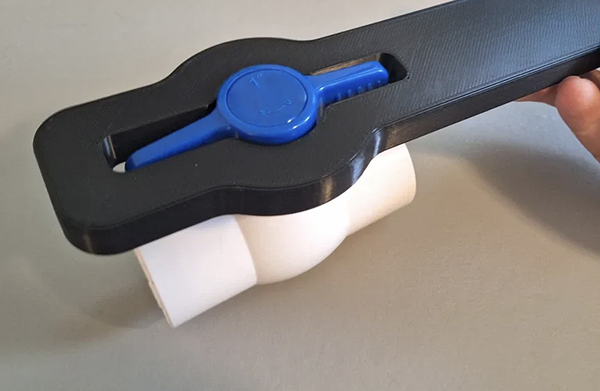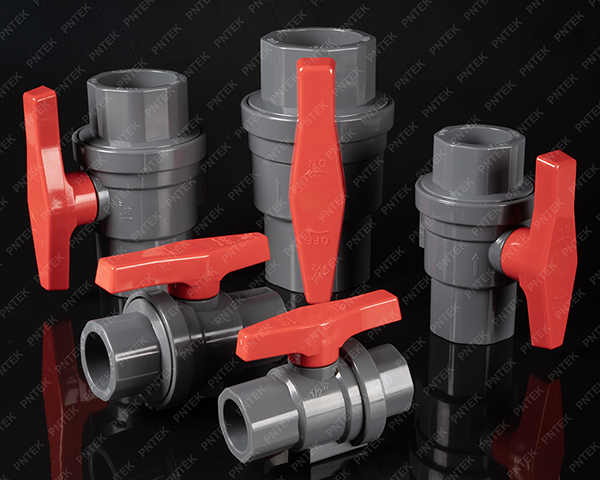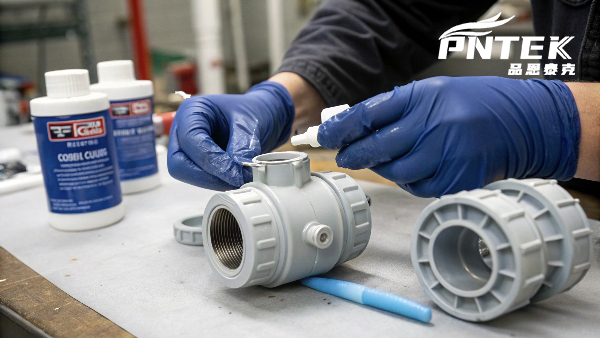Your PVC valve is stiff and you reach for a can of spray lubricant. But using the wrong product will destroy the valve and can cause a catastrophic leak. You need a correct, safe solution.
Yes, you can lubricate a PVC ball valve, but you must use a 100% silicone-based lubricant. Never use petroleum-based products like WD-40, as they will chemically damage the PVC plastic, making it brittle and prone to cracking.

This is one of the most critical safety lessons I teach partners like Budi. It’s a simple mistake with serious consequences. Using the wrong lubricant can lead to a valve bursting under pressure hours or days after the application. When Budi’s team can explain to a customer why a household spray is dangerous and what the safe alternative is, they move beyond selling a product. They become a trusted advisor, protecting their customer’s property and safety. This expertise is fundamental to building the long-term, win-win relationships we value at Pntek.
How to make a PVC ball valve turn easier?
The valve handle is too stiff to turn by hand. Your first thought is to grab a big wrench for more force, but you know this could crack the handle or the valve body itself.
To make a PVC valve turn easier, use a tool like channel-lock pliers or a strap wrench to gain more leverage. It is critical to grip the handle close to its base and apply steady, even pressure.

Brute force is the enemy of plastic plumbing parts. The solution is using smarter leverage, not more muscle. I always advise Budi’s team to share this proper technique with their contractor customers. The number one rule is to apply force as close to the valve stem as possible. Gripping the handle at the very end creates a lot of stress that can easily snap it off. By using a tool right at the base, you are turning the internal mechanism directly. A strap wrench is the best tool because it will not scratch or damage the handle. However, channel-lock pliers are very common and work just as well when used with care. For a brand new valve that is not yet installed, it is good practice to work the handle back and forth a few times to break in the seals before you glue it into the line.
Do ball valves need lubrication?
You wonder if lubricating your valves should be part of regular maintenance. But you are not sure if it is necessary, or if adding a chemical could do more harm than good in the long run.
New PVC ball valves do not need lubrication. They are designed to be maintenance-free. An old valve that has become stiff might benefit, but this often signals that replacement is the better long-term option.

This is a great question that gets to the heart of product design and lifecycle. Our Pntek ball valves are designed to be installed and then left alone. The internal components, especially the PTFE seats, are naturally low-friction and provide a smooth seal for thousands of turns without any help. So, for a new installation, the answer is a clear no—they do not need lubrication. If an older valve becomes stiff, the need for lubrication is really a symptom of a deeper problem. It usually means hard water has deposited mineral scale inside, or debris has scored the surfaces. While silicone grease might provide a temporary fix, it cannot repair that underlying wear and tear. Therefore, I always coach Budi to recommend replacement as the most reliable and professional solution for a failing valve. It prevents a future emergency call-out for his customer.
Why are PVC ball valves so hard to turn?
You have just unboxed a new valve, and the handle is surprisingly stiff. Your immediate concern is that the product is defective, and it makes you question the quality of your purchase.
A new PVC ball valve is hard to turn because the factory-fresh, high-tolerance PTFE seats create a very tight and dry seal against the ball. This initial stiffness is a sign of a quality, leak-proof valve.

I love explaining this because it turns a negative perception into a positive one. The stiffness is not a bug; it is a feature. To guarantee our valves provide a perfect, drip-free shutoff, we manufacture them with extremely tight internal tolerances. When the valve is assembled, the smooth PVC ball is pressed firmly against two new PTFE (Teflon) seat seals. These brand-new surfaces have a high degree of static friction. It takes more energy to get them moving for the first time. Think of it like a new pair of shoes that needs to be broken in. A valve that feels very loose and easy to turn right out of the box might have lower tolerances, which could eventually lead to a small, weeping leak under pressure. So, when a customer feels that solid resistance, they are actually feeling the a quality seal that will keep their system secure.
How to fix a sticky ball valve?
A critical shutoff valve is stuck solid, and simple leverage is not working. You are facing the prospect of cutting it out of the line, but wonder if there is one last thing you can try.
To fix a sticky ball valve, you must first depressurize the line, then apply a small amount of 100% silicone grease. Often, you will need to disassemble the valve to reach the internal ball and seats.

This is the last resort before replacement. If you must lubricate, doing it correctly is essential for safety and function.
Steps for Lubricating a Valve:
- Shut Off the Water: Turn off the main water supply upstream from the valve.
- Depressurize the Line: Open a faucet downstream to drain all water and release any pressure from the pipe. Working on a pressurized line is dangerous.
- Disassemble the Valve: This is only possible with a “true union” style valve, which can be unscrewed from the body. A single-piece, cemented solvent-weld valve cannot be taken apart.
- Clean and Apply: Gently wipe any debris or scale from the ball and seat area. Apply a very thin film of 100% silicone grease to the ball. If it is for drinking water, ensure the grease is NSF-61 certified.
- Reassemble: Screw the valve back together and slowly turn the handle a few times to spread the lubricant.
- Test for Leaks: Slowly turn the water back on and carefully check the valve for any leaks.
However, if a valve is this stuck, it is a strong sign it is at the end of its life. Replacement is almost always the faster, safer, and more reliable long-term fix.
Conclusion
Only use 100% silicone grease a PVC valve; never use petroleum products. For stiffness, try proper leverage first. If that fails, replacement is often the best long-term fix.
Post time: Sep-04-2025




